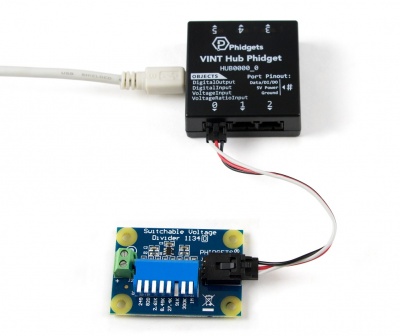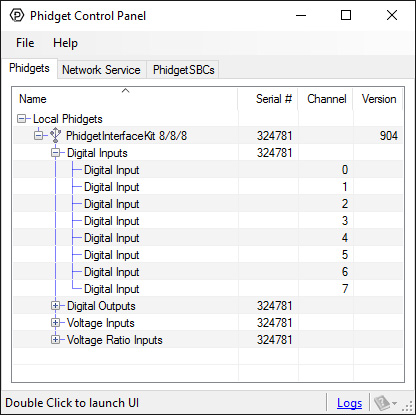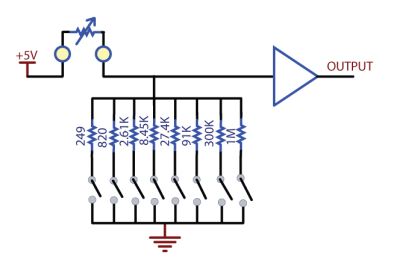1134 User Guide: Difference between revisions
No edit summary |
|||
| Line 26: | Line 26: | ||
===Formulas=== | ===Formulas=== | ||
The Formula to translate | The Formula to translate voltage from this sensor into resistance is: | ||
::<math>\text{Resistance (Ohms)} = R_{eq} \times \frac{ | ::<math>\text{Resistance (Ohms)} = R_{eq} \times \frac{5}{\text{Voltage} - 0.005}</math> | ||
Where R<sub>eq</sub is the equivalent resistance of the switches that are flipped on in Ohms. The Switchable Voltage Divider has an internal buffer on the output. This allows the output to be read without distortion caused by the device reading the measurement, such as the PhidgetInterfaceKit. | Where R<sub>eq</sub> is the equivalent resistance of the switches that are flipped on in Ohms. The Switchable Voltage Divider has an internal buffer on the output. This allows the output to be read without distortion caused by the device reading the measurement, such as the PhidgetInterfaceKit. | ||
===Configuring the Voltage Divider=== | ===Configuring the Voltage Divider=== | ||
Revision as of 20:39, 13 April 2017
Required Hardware
- A 1134 Voltage Divider
- An InterfaceKit or Hub to read the divider
- A Phidget cable
- A USB cable
- A computer
- A variable resistance sensor
Connecting the Pieces

- Connect the voltage divider to the InterfaceKit or Hub with the Phidget cable.
- Connect a variable resistance sensor to the terminal block on the voltage divider.
- Select an appropriate measurement range for your application by toggling the desired DIP switch. We are toggling the 27.4K switch. When the switch is down, the associated measuring resistor is selected. It is possible to have more than one switch toggled and have the resistors in parallel.
- Connect the InterfaceKit or Hub to your computer with the USB cable.
Testing Using Windows
Phidget Control Panel
In order to demonstrate the functionality of the 1018, the Phidget Control Panel running on a Windows machine will be used.
The Phidget Control Panel is available for use on both macOS and Windows machines.
Windows
To open the Phidget Control Panel on Windows, find the ![]() icon in the taskbar. If it is not there, open up the start menu and search for Phidget Control Panel
icon in the taskbar. If it is not there, open up the start menu and search for Phidget Control Panel
macOS
To open the Phidget Control Panel on macOS, open Finder and navigate to the Phidget Control Panel in the Applications list. Double click on the ![]() icon to bring up the Phidget Control Panel.
icon to bring up the Phidget Control Panel.
For more information, take a look at the getting started guide for your operating system:
Linux users can follow the getting started with Linux guide and continue reading here for more information about the 1018.
First Look
After plugging the 1018 into your computer and opening the Phidget Control Panel, you will see something like this:

The Phidget Control Panel will list all connected Phidgets and associated objects, as well as the following information:
- Serial number: allows you to differentiate between similar Phidgets.
- Channel: allows you to differentiate between similar objects on a Phidget.
- Version number: corresponds to the firmware version your Phidget is running. If your Phidget is listed in red, your firmware is out of date. Update the firmware by double-clicking the entry.
The Phidget Control Panel can also be used to test your device. Double-clicking on an object will open an example.
Voltage Input
Double-click on a Voltage Input object in order to run the example: [[Image:{{{1}}}_VoltageInputSensor_Example.jpg|center|link=]]
General information about the selected object will be displayed at the top of the window. You can also experiment with the following functionality:
- Modify the change trigger and/or data interval value by dragging the sliders. For more information on these settings, see the data interval/change trigger page.
- If you have an analog sensor connected that you bought from us, you can select it from the Sensor Type drop-down menu. The example will then convert the voltage into a more meaningful value based on your sensor, with units included, and display it beside the Sensor Value label. Converting voltage to a Sensor Value is not specific to this example, it is handled by the Phidget libraries, with functions you have access to when you begin developing!
For more information about Voltage Inputs, check out the Voltage Input Primer.
Testing Using macOS
- Go to the Quick Downloads section on the macOS page.
- Download and run the Phidget macOS Installer
- Click on System Preferences >> Phidgets (under Other) to activate the Preference Pane
- Make sure your device is properly attached
- Double click on your device's objects in the listing to open them. The Preference Pane and examples will function very similarly to the ones described above in the Windows section.
Testing Using Linux
For a general step-by-step guide on getting Phidgets running on Linux, see the Linux page.
Using a Remote OS
We recommend testing your Phidget on a desktop OS before moving on to remote OS. Once you've tested your Phidget, you can go to the PhidgetSBC, or iOS pages to learn how to proceed.
Technical Details
The 1134 Switchable Voltage Divider is a voltage divider with switches. The switches can be used to control which resistors are used in the voltage divider. From left to right, the resistance values (in Ohms) are 249, 820, 2.61K,8.45K, 27.4K, 91K, 300K and 1M. It is possible to have multiple switches flipped, putting the corresponding resistors in parallel.
Formulas
The Formula to translate voltage from this sensor into resistance is:
Where Req is the equivalent resistance of the switches that are flipped on in Ohms. The Switchable Voltage Divider has an internal buffer on the output. This allows the output to be read without distortion caused by the device reading the measurement, such as the PhidgetInterfaceKit.
Configuring the Voltage Divider
| To optimize the voltage divider to meet your needs, you have to adjust the switchable resistance to match the characteristics of your chosen variable resistor. First, adjust the resistance for no stimuli on your sensor, then apply maximum stimuli and make sure that the Sensor Value stays within a range that gives you an acceptable resolution. The formula is most accurate at a SensorValue of 500, with an error of 0.4%. At 100 and 900, the error increases to approximately 1.1% and at 50 and 950, it increases to 2.1%. As a general rule, if the SensorValue is over 900, a lower resistance should be switched in. If the SensorValue is below 100, a higher switch should be toggled. Continue adjusting the switches until you find an acceptable range. | 
|
Warning: It is possible for the 1134 to apply up to 5V to the variable resistor. If the resistor cannot handle this voltage, it can be damaged. The 1134 is a very simple way of measure resistance. When interfacing to sensors with small resistances (like 100 ohm RTDs, for instance), large currents can flow - up to 30 mA. This level of current may cause substantial heating in the variable resistor, distorting the measurement or even possibly permanently damaging it.
Variable resistance sensors
Here are some interesting variable resistance sensors that could be used with the Voltage Divider.
| Sensor Type | Manufacturer | Example | Digikey Search |
| Light Sensors | Advanced Photonics | PDV-P9003-1 | photcell |
| Force Sensors | CUI Inc. | IESP-12 | force sensor |
| Thermistors | US Sensor | 615-1037-ND | termistor radial |
| Bend Sensors | imagesco.com | FLX-01 | n/a |
Analog Input Cable Connectors
Phidget Cable

The Phidget Cable is a 3-pin, 0.100 inch pitch locking connector. Pictured here is a plug with the connections labelled. The connectors are commonly available - refer to the Analog Input Primer for manufacturer part numbers.
What to do Next
- Programming Languages - Find your preferred programming language here and learn how to write your own code with Phidgets!
- Phidget Programming Basics - Once you have set up Phidgets to work with your programming environment, we recommend you read our page on to learn the fundamentals of programming with Phidgets.

